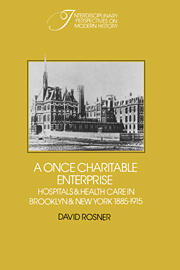Book contents
- Frontmatter
- Contents
- Preface
- Introduction
- 1 Health care and community change
- 2 Embattled benefactors: the crisis in hospital financing
- 3 Social class and hospital care
- 4 Conflict in the new hospital
- 5 Taking control: political reform and hospital governance
- 6 Consolidating control over the small dispensary: the doctors, the city, and the state
- 7 The battle for Morningside Heights: power and politics in the boardroom of New York Hospital
- 8 Looking backward
- Notes on sources
- Notes
- Select bibliography
- Index
5 - Taking control: political reform and hospital governance
Published online by Cambridge University Press: 07 October 2009
- Frontmatter
- Contents
- Preface
- Introduction
- 1 Health care and community change
- 2 Embattled benefactors: the crisis in hospital financing
- 3 Social class and hospital care
- 4 Conflict in the new hospital
- 5 Taking control: political reform and hospital governance
- 6 Consolidating control over the small dispensary: the doctors, the city, and the state
- 7 The battle for Morningside Heights: power and politics in the boardroom of New York Hospital
- 8 Looking backward
- Notes on sources
- Notes
- Select bibliography
- Index
Summary
Although internal economic and organizational struggles altered the structure of many turn-of-the-century hospitals, some changes were the result of new policies in city government. Changes made during this era in the system of municipal reimbursement to the hospital have remained important until today and have had significant long-term effects. Local control and some forms of decision making passed from hospital trustees and their ward boss representatives to city administrators, who defined more narrowly the hospital work they would reimburse. Ultimately, changes in the municipal reimbursement system resulted in a loss of autonomy for many hospitals and a loss of funds so severe that some were forced out of existence.
The Tammany machine and flat-grant payments for charity
In the years after the Civil War, control over New York's political machinery moved to the infamous Tammany Hall led by Mayor William Marcy Tweed, Richard Croker, and Charles F. Murphy. With only brief interruptions totaling ten years, Tammany politicians controlled the mayor's office, the administrative machinery, and the patronage jobs of New York's government for nearly three-quarters of a century. Unlike the later Progressives, who appealed for financial support to the upper- and middle-class populations of the city's neighborhoods, the Tammany machine based its power on its ability to gain political support from the working populations of highly diverse communities. Tammany's power was its local ward structure and, most particularly, the ability of its ward boss to gather votes and support in his district.
- Type
- Chapter
- Information
- A Once Charitable EnterpriseHospitals and Health Care in Brooklyn and New York 1885–1915, pp. 122 - 145Publisher: Cambridge University PressPrint publication year: 1982

